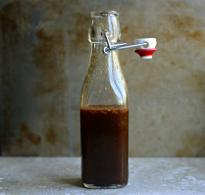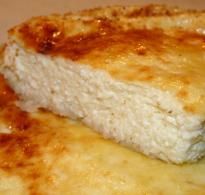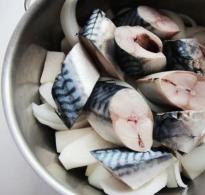Not so difficult - we cook dried pork at home. A selection of simple homemade pork jerky recipes
The taste is much superior to more purchased sausages. However, to the same extent they surpass them in prices. Therefore, lovers of delicious food sadly pass by tempting shop windows, allowing themselves this luxury only on major holidays. But gourmets in vain limit themselves to their favorite dish, since it is not so difficult to make dry-cured meat at home. Of course, you will have to wait - the process is quite lengthy. However, you can adjust the flavors by adding the spices you like and removing the ones you don't. In addition, dry-cured meat, made at home and with love, will definitely be from high-quality sources and with an unexpired expiration date.
Simply withering raw beef, poultry or pork can only be done by someone who has special equipment. The rest must marinate the meat first.
"Wet" curing
Home cooking of dry-cured meat begins with salting it. Consider for a start the traditional method using brine. It will take about a liter for every pound of meat. The water is boiled, salt dissolves in it (two heaped spoons per liter), a little sugar is added, a full tablespoon of red and black pepper, peppercorns and bay leaf - like on pickles. It will boil for three minutes - it turns off and cools down. The bay leaf should be discarded - it will add bitterness and not a very pleasant smell. The meat is cut into medium, dipped in brine and left in it for five hours right in the kitchen. Then put in a cool place for three days. Then the liquid is decanted, and the meat is placed under the press until moisture stops appearing, after which a mixture of red and black pepper is rubbed into it (other spices can also be added). The slices are wrapped in clean gauze, placed in a resealable bowl and placed in the refrigerator for a week. During this time, they are qualitatively marinated. The meat is again rubbed with spices, wrapped in a clean cut and hung out in a dry place where it will not interfere. A week later, dry-cured meat (at home it has reached the desired condition) is served on the table. In the refrigerator, it will not spoil for three months.

"Dry" method
This option, how to make dry-cured meat at home, is usually chosen by those who believe that beef (pork / poultry) is too saturated in brine with unnecessary moisture. A whole piece is taken and very carefully rubbed with a mixture of spices from two tablespoons of salt, one - sugar, half - coarsely ground black pepper, the same amount of crushed juniper berries and chopped seven bay leaves (everything is calculated per kilo of raw materials). The future dry-cured meat is tightly wrapped in cling film, a weighty load is placed on it, and the whole structure is put in the refrigerator for at least a week. You will have to regularly drain the meat juice, otherwise the product may deteriorate. Then the chunk is dried, rubbed with the same composition of seasonings, laid out on a wire rack and hidden back for two weeks. Turn over at least once every two days! Ready dry-cured meat is wrapped in paper or put into a paper bag. Please note: cooked according to this method, it will “live” in the refrigerator for no longer than a month.
Spicy beef jerky
So far, we've covered the basics, so to speak. They can be used to cook any dry-cured meat at home. However, there are many refinements, applying which, you can get a tastier treat. For example, you can do differently with beef - the result will be much more aromatic and will “ripen” faster. A large piece of meat is taken, cleaned of excess veins and cut along the entire slice into thin strips - 5 centimeters each, not thicker. 10 washed large blackcurrant leaves, two “burdocks” of horseradish, a couple of cinnamon sticks, a full spoonful of chopped ginger, 400 grams of salt, bay leaf and peppercorns are placed in boiling water (2 liters). This amount of brine is enough for as much as 10 kilos of beef. The trick is that the pieces of meat are dipped in brine for three minutes, then cooled, strained and hung in gauze bags for 10 days in a dry and dark place. Temperature is not as important as good ventilation and lack of light.

Quick Drying
You can also get dry-cured meat using the oven. The recipe involves cutting the beef into very small pieces (about 5 x 5 cm). Moreover, before the main processing, the washed and dried meat is removed into the freezer, so that it is easier and smoother to cut. Sprinkling is made of salt (60 g), ground black pepper (10 g) and hot red pepper (5 g). Beef cubes are rolled in it, left for 10 minutes to soak with spices and laid out on a wire rack so that they do not touch. The oven is heated to 40 degrees, a grate is placed in it and left to dry for half a day.
Grilled
For this method, the beef will have to be cut even more thinly - two centimeters wide, and in shorter strips - along the length of the grill grate. Spices (cinnamon, black pepper, red pepper, salt) are mixed in a ratio of 2:5:5:60. All the pieces are rubbed with the mixture, laid out at intervals on the grate and dried for about seven hours. The disadvantage that such dry-cured meat has is a short shelf life. Two weeks, no more. However, it gets eaten much faster. Pork can be dried in the same way, only cumin is taken instead of red pepper, and the meat is chosen leaner.

Dry-cured pork
Most of the people are sure that it is contraindicated to dry pork: they say, it is fatty, it is not fully saturated and quickly disappears. You just don't know how to cook it! In our opinion, the only drawback that home-cooked pork (raw-cured meat) has is that it cannot be made in a large piece. But if you cut it into small slices, it will come out delicious! Pieces should be no larger than 4 centimeters. Each is rolled in a mixture of coriander, a set of Italian or other herbs, white and black pepper (their amount is up to you), a tablespoon of coarse salt and a teaspoon of sugar. All this is enough for half a kilogram of pork. The pieces are stacked in a tray, sprinkled moderately with vodka (half a stack is enough) and settle for 14 hours on the bottom shelf of the refrigerator. Juice must be drained! Then the excess liquid is removed, and the marinated meat in a gauze bag is hung on the ledge in the kitchen for one and a half to two weeks. Enjoy your health!

Dried chickens
You can also cook dry-cured meat from poultry. The recipe, again, should not cause any particular difficulties. The simplest possible option: a carcass of any size is taken, carefully rubbed with salt inside and out, wrapped in parchment (for lack of it, you can wrap it in cellophane, but you have to ventilate it), tightly tied with twine and hung in the pantry (or in the garage, if it doesn’t stink there). gasoline. Actually, anywhere, as long as it is dark and cool). You can eat after a couple of months. And it can be stored up to three years.

Sun-dried with garlic
It is clear that the method described above is, rather, a method of harvesting, rather than preparing a treat. If you want something tasty, you will have to try, since you can cook dry-cured chicken meat only separately from its backbone. That is, the carcass will have to be thoroughly washed and separated from all the meat parts from the bony ones. The pulp is cut into thin strips, the garlic is finely chopped and ground in a mortar with salt at the rate of half a glass of the latter per head of garlic. Strips are rubbed with this mixture, laid out in bags (our people recommend old but clean nylon socks) and hung out in the warmth, but in a draft for 10 days.
Juniper chicken thighs
Many in childhood dreamed that scientists would breed chickens with ten legs - then children would get more tasty parts of the body. For those who have remained faithful to children's ideas and have not exchanged them for the rules of dietary nutrition, this is our recipe.

We take the legs, wash them and rub them abundantly with salt (for 10 kilograms of legs - 300 g of salt), mixed with cinnamon (a teaspoon) and sugar (5 tablespoons). All wealth is laid out in a voluminous bowl, sprinkled with juniper berries (1/5 kilogram). Another 300 g of salt is dissolved in hot water (10 l) and boiled with cloves and peppercorns. The legs are poured with a filtered solution, a weighty press is placed on them for 3 hours. At the end of the salting, the legs are filtered, wetted and dried for a month in a fairly cool (about 10 degrees) room. That's when happiness comes!
Recipe from Andrey from the Plate website. RU
Thanks a lot!
This recipe is found not only in Belarusian, but also in Polish and Lithuanian cuisines.
If meat is taken - fillet (along the back) - it is called polendvitsa, if the ham (pig thigh) is called kumpyak.
Compound
2-3 pork fillets - about 1.2 kg
All spices in grains:
2 tbsp. l. black pepper and coriander
1 st. l. cumin
10 peas of allspice and juniper berries
coarse salt 100 - 150 gr. (for 1 kg.)
Author's words:
"Grate the meat with coarse salt, place in a ceramic mold, put in the refrigerator for salting for 1-2 days (turning 2 times a day).
Wipe the meat, dry it, sprinkle with a mixture of spices ground in a mortar (before that, dry them in a dry frying pan), wrap in gauze, wrap with cooking thread, hang in a dry, ventilated room for 2-3 days (until a dry crust forms).
Then outweigh in a cool, dry place for 2-4 weeks. Remove cheesecloth, cut into thin slices, serve as an appetizer."
Meat is better to take fresh (chilled), frozen - the taste is not the same.
And it is better to cut along the length to reduce the thickness (this time I did not).
I had a sirloin, but with fat - 1 kg.
I divided it into 2 parts - I made one half dry in the classical way (according to the recipe - rubbed with coarse salt), the second - wet (advice from the comments).
I wanted to experiment.
I used sea salt, as this is the only large one.
I took the upper limit - 150 gr. divided by 2 (for half a kilo) - used 75 gr. .
In a ceramic dish - salt to the bottom, salt again meat and turn well. Cover with cling film. To the refrigerator.
Do not forget to turn over 2-3 times a day.

The second piece - in saline solution - 150 gr. salt dissolved in 1 liter of hot water. When it cooled down, put the meat in.
To the refrigerator. We turn over.

According to the recipe, it should be kept in salt for no more than 2 days for the dry method and up to a day for the wet method, and then transferred to a draft. But our temperature has risen sharply from 28 to 38 degrees. and I had to keep the meat for 5 days in the refrigerator.
Then, all the spices in the pan and dry over low heat for a couple of minutes.
In a coffee grinder or mortar.
Don't feel sorry for Pepper. According to the author, "the extra pepper can then be shaken off, but if it is not enough right away, then nothing can be fixed. The meat will be insipid and inexpressive."

Wipe the meat with paper towels and rub the spices on all sides without sparing.

Transfer to cheesecloth. And it’s better and more economical to wrap it with a wide bandage in layers of 3-4, and then tie it with a culinary or ordinary dense thread and make a small loop at the end.

Now we hang the pieces in a draft.
This is a very important point - because it is thanks to this that a dry crust is formed on the meat, under which it ripens.
If not, then the product may deteriorate.
Such a place can be on the balcony - for this, the meat is placed in a cardboard box. by making holes in it. Some hang on a draft in the kitchen by the window.
Or artificial ventilation is used.
Since I don’t have a balcony and vents too, I specially bought the smallest and cheapest table fan (energy saving).

She put a stick (sports) on the table, on two chairs and attached meat to it.
And I had meat in a draft not for 3 days, but, given the temperature, for about a week.
Then it is necessary to outweigh in a dry, cool place for 2-4 weeks for ripening.
It can be an attic, a balcony (it is better to seal the holes in the box with tape), a cool hallway, a window cornice, or, in extreme cases, in a refrigerator on the bottom shelf.
I have the last option and lay for 4 weeks (I always play it safe in such things).
Although the author says that you can navigate like this - "it's easy to check - cut it off and eat it. If the meat is evenly dried out, then its color will be uniform, if it is pink in the center of the slice (a speck with clear edges), then it is not yet ripe. But you can eat and such, just a bouquet of flavors will be flat, not as bright as it can be .. "

Remove cheesecloth, cut into thin slices.

Meat according to the classic dry recipe turned out tasty, but a little salty.
5 days was too much. Dry method, indeed, should be kept no more than 2 days.


But the wet method shocked me!
I didn't expect such a great result!
The taste of dried meat of the highest grade according to Soviet GOST!

Complement - we have a similar recipe from Danuula
Unfortunately, I did not take step-by-step photos, since this is my first such experiment. But to be honest, the sample was taken on the 10th day, it turned out just divine. But, it’s better for the meat to lie down for another week, I’m sure that the taste from this will be even richer
So, we take a beef tenderloin, I had a long rump of a very beautiful even shape, weighing 1.2 kg. 9-10 cm in diameter. I even wanted to cut it lengthwise into 2 pieces, as I was afraid that it would not salt inside. But I did the following, I froze this piece for 4 days, and before freezing I washed the meat and put it under load, after an hour I got an oval piece with exact dimensions (length 33, width 12-13, and the height due to flattening turned out to be about 6-7 cm ), wrapped the resulting form in a bag and sent it to the freezer.
After defrosting, I prepared a deep dish similar to a baking sheet (I have a glass one, it’s convenient to wash, it doesn’t absorb smells), I took a very large non-iodized salt (I found this on the market a long time ago, I bought as much as 15 kg in stock). We do not regret salt, 1 kg is quite good so that the meat is covered with salt on all sides with a decent layer. For 1 kg of salt, add one teaspoon of black pepper, roll a piece of meat in the resulting mixture and put it in a bowl, sprinkling with an even layer of salt and pepper on all sides. We cover with cling film and send it to the refrigerator for 3 days, every day we open the film, and turn the meat over.
After 3 days, we wash the meat from salt (I used filtered water), remove the remaining salt from the bowl and pour filtered water, put our piece of meat for soaking. It is necessary to remove excess salt, otherwise there will be a decent oversalting. According to statistics, for every day of salting, you need 1 hour of soaking, I soaked for about 2 hours, turning every 30 minutes and changing the water once an hour. After, you need to put our meat under the press, remove the remaining moisture with napkins.
While the meat is being “squeezed”, we prepare a mixture of spices: 3 tablespoons of paprika, 1 tablespoon of black pepper, one teaspoon of hot pepper (if you like it spicier, you can add a tablespoon instead of a teaspoon), two pinches of ground mint, Garam masala added " per eye", about 3 pinches (next time I'll add a teaspoon, I'm sure I won't harm the taste), a teaspoon of sugar, mix it all up and add a spoonful of soy sauce, mix again. On a garlic press, crush 10 cloves of garlic into a separate bowl, I took large cloves. For wrapping, you can use gauze, I like to use chintz.
So, our meat has released excess moisture and is ready for further action. We take the garlic mass and begin to rub it into the meat, as if doing a massage, rub it more thoroughly so that a kind of sticky crust forms, the garlic juice is absorbed into the meat, and the garlic mass remains on the palms. We love garlic, so some of the garlic mass was also used for the crust. We coat our meat with a mixture of spices on top of the garlic peel, it turns out about a two millimeter crust. We put the meat on the chintz, wrap it and wrap it tightly with threads.
We send the finished briquette to the refrigerator, I have a top shelf for this, but this time I hung it on the side door, the second option is more effective, but the side door is not always free. After a day, we take out our meat, unfold and change the chintz, as the moisture will come through and be absorbed into the rag. We also wrap it tightly with threads, send it to the refrigerator and wait. My meat hung for a week, then I put it on a shelf, turn it over once a day.
After 10 days I took a sample, my wife said that this was my most delicious meat experiment. He did the right thing by not cutting the piece of meat into 2 parts, the meat had shrunk decently, and now the size of the cut piece is just perfect.
We cut thinly and enjoy, you can invite guests, but then the meat will end very quickly
Marinade is cooked from these ingredients, to obtain which it is necessary to bring water with spices to a boil, cool and strain. Then the meat itself is put into it.
A piece of pork should “float” in the marinade for at least three days, while the liquid should completely cover the meat from above. Twice a day for better absorption, it is necessary to turn over in the container.
Next stage:
At the end of three days, the salted pork neck is removed from the marinade, dried with napkins and placed under the press. For a piece of 2-3 kg, this can be a 20-liter container of water. It removes excess liquid from the meat in 3-5 hours, after which the future dried neck is ready for further cooking. A spicy powder is prepared for it, which is obtained by mixing:
- crushed coriander;
- ground black pepper;
- adjika dry;
- paprika.
All ingredients are taken in one teaspoon, except for coriander and paprika, which are added in the amount of a tablespoon. Everything is homogeneously mixed, the meat is rolled in spices from all sides, wrapped in several layers of gauze.
Meat aging
For the first week, the salted pulp lies in gauze in a closed container in the refrigerator, after which its storage conditions change. Gauze must be tightly tightened with twine, which will contribute to the release of excess juices.
Dry-cured meat should be blown in the wind at a positive temperature not exceeding 8 degrees Celsius for a month. Finding such conditions is not always easy, especially if it is winter or summer outside. In this case, the dried neck is ideally obtained in refrigerators with the No Frost system: the meat is blown from all sides, but at the same time it is in the cold.
Due to the fact that the meat itself in this part of the pork carcass is with thin layers of fat, the dry-cured neck is tender, soft and tasty. Its only drawback is that it is rather difficult to cut into thin slices, since the consistency of the meat is quite dense, but this does not adversely affect the taste.
Bon appetit!
Thanks to Elena Kirichenko for the recipe and photo.
Cooking real jerky, just like in children's books about Indians and natives, is quite possible in an ordinary apartment.
The simplest option for making corned beef is dried pork.
It is responsive to spices, contains a lot of fat and has sufficiently soft fibers, so that even an inexperienced cook is not so easy to overdry the product. Try to use our recipes and be sure to carefully follow the technology, do not risk your health and those of your loved ones.
Dried Pork at Home - General Cooking Principles
Dried meat at home is not so difficult, special devices are not required for this. There are several common ways to dry pork: outdoors, in the refrigerator, and the fastest way is in the oven.
Before curing the pork, it must first be well salted. There are two ways of salting: dry and marinated. With dry salting, the meat is placed in a small container with a tightly closed lid, along the bottom of which half a measure of salt is scattered, and the rest is poured over the meat. For several days, the pork is kept in the refrigerator, after which it is washed and rolled in spices. The principle of salting meat in the marinade is similar, but after such salting, the corned beef is not washed, but thoroughly dried from moisture, and then rolled with spices.
After the meat is well salted and rolled in spices, the pieces are tightly wrapped with parchment or gauze and placed in a cool place, preferably in a suspended state. If this is not possible, you can put the packages in the refrigerator and, in the process of drying, turn them over at least twice a day.
The duration of the process depends on the method of salting and the specific recipe. Pork can dry from several days to a month, cooking in the oven takes up to six hours.
To store dried pork at home, use a refrigerator. Ready-made pieces of pulp are wrapped in parchment or loose fabric (gauze can be used) and left on a shelf. Do not store corned beef in tight, non-breathable packaging; it may become moldy.
Dried pork is served as an appetizer with strong alcoholic drinks or wine. It can be taken on long trips by making sandwiches.
Dried pork at home with cognac salted with dry salting
Ingredients for 1 kg tenderloin:
One kilogram of table salt "salted" grinding;
2 chili peppers, substitute 2 tbsp. l. sharp, ground;
Two spoons of cognac;
Dried sage - 2 tbsp. l.;
Eight tablespoons of freshly ground black pepper;
A handful of coriander seeds.
Cooking method:
1. If using fresh chile peppers, remove seeds and chop. You can grind the pepper with a blender or grate using the finest grater.
2. Mix salt with all seasonings, add chopped chili or two tablespoons of ground red, add cognac and mix well. The mixture should only be slightly moistened.
3. Put half of the prepared mixture into a container of a suitable size, place a piece of pork washed, dried from moisture on it and cover it with the remaining mixture of spices and salt.
4. Wrap the container tightly with cling film and place in the refrigerator. After twelve hours, remove, thoroughly wash off the adhering salt and spices, dry.
5. Wrap a piece of pork with a thin breathable cloth, and it is best to wrap it in cheesecloth and put it back in the refrigerator for twelve hours.
6. At the end of the exposure, rub well with coriander seeds ground in a mortar, wrap in gauze. Tie in several places with twine and hang in a well-ventilated room. You can put it in the refrigerator, but at the same time it will need to be turned over at least three times a day.
7. After a week and a half, the first sample can be taken from dried pork.
Dried pork at home salted in marinade
Ingredients for 700 gr. meat
For marinade:
Liter of water;
150 gr. coarse salt;
Spoonful of sugar;
Two large leaves of lavrushka;
Allspice - 3 peas;
Carnation umbrella;
Five peas of black, preferably large, pepper.
In the meat boning mixture:
Black, hand-ground pepper - 1 tsp;
a teaspoon of coriander seeds;
Chili pepper - a small pod;
Ground paprika and rosemary - a spoonful;
A teaspoon of cumin;
a tablespoon of salt;
Ground lavrushka - 0.5 tsp;
Additionally:
A piece of gauze and parchment paper.
Cooking method:
1. Bring water with salt diluted in it to a boil. Add sugar, lower the parsley, put the cloves with peppercorns. Boil the marinade for a couple of minutes, then set aside and cool completely.
2. Dip a piece of pulp thoroughly washed with water into the marinade, put a small load on top, pressing down the fillet so that it is completely in the liquid. Put the container in the refrigerator for 2 days.
3. Remove the marinated piece of pulp from the marinade and dry it well by wiping it with a towel.
4. Mix all the spices and spices intended for deboning. Before adding rosemary, coriander, cumin and black pepper, grind them by grinding in a mortar or grinder in a coffee grinder.
5. Rub the dried pulp with a spice mixture, wrap it tightly with parchment and tie it in several places with twine. Place the bundle for three days in the cold, in the common chamber of the refrigerator.
6. Free the pork from the paper. Add a little more of the same spices and wrap it tightly in gauze, which is secured with a thread. The fabric should fit snugly, completely covering the piece.
7. For five days, hang the bundle in a draft in a cool room.
Recipe for homemade cured pork soaked in vinegar
Ingredients:
Two kilograms of pork pulp from the neck or carbonate;
Rock salt - 1 kg.
For the ambassador:
Vinegar 6% grape or apple - 1 liter;
Garlic - 4 large cloves;
Crushed paprika, black pepper - a teaspoon;
A small pinch of ground oregano or thyme
A mixture of spices and herbs for drying:
A large spoonful of salt;
Hot pepper - a pinch;
A spoonful of coriander and the same amount of a mixture of dried herbs (oregano, thyme, Provence herbs, dry parsley).
Cooking method:
1. Rinse the meat with cold water. Cut off any unevenness to give a more oblong shape and dry thoroughly by blotting with a towel.
2. Pour half of the salt into a large plastic container, smooth it out and put a piece of pulp on top. Sprinkle it with the remaining salt, close the container tightly and put it in the refrigerator.
3. Not earlier than after three days, remove the pork from the refrigerator. During this time, excess moisture will come out of it, and it will have time to absorb the salt well. Rinse the pulp under cold running water and place on a wire rack or towel to dry.
4. In a large bowl, mix finely chopped garlic with ground paprika and black pepper. Add thyme or oregano, add vinegar, mix again and dip the dried meat into the prepared brine. Soak the pork in the brine for half an hour, turning the piece occasionally.
5. While the meat is soaking, in a separate dry bowl, mix the spices and herbs intended for curing with a spoonful of salt. Take a large sheet of parchment and sprinkle the prepared mixture in the center.
6. Remove the soaked pork, and dip the wet piece on all sides in the spices poured onto the parchment. The pulp should be completely covered with a fragrant layer.
7. Tightly wrap a piece of pork in parchment, for reliability, drag it in several places with a tight rope and put it in the refrigerator for three weeks.
Dried pork at home for three days
Ingredients:
Low-fat pork tenderloin - 600 gr.;
Three large spoons of salt;
A teaspoon of a mixture of ground peppers;
A dessert spoon of vodka, if there is alcohol, it is better;
Two large cloves of garlic.
A quarter of a spoon of red pepper, grated in a mortar.
Cooking method:
1. In a small bowl, mix spices with salt. Pour vodka into the mixture, stir.
2. Rub the washed and dried pulp on all sides with the mixture. Place the piece in a food container, cover and refrigerate for 12 hours or more. During this time, it is advisable to turn the meat twice.
3. After that, wash off all the spices with running water. Dry the piece with a towel and rub with finely chopped garlic.
4. Wrap the seasoned pork in cheesecloth so that the fabric fits snugly around it and put it back in the refrigerator, or best of all, hang it in it. If hanging is not possible, periodically turn the piece over so that it dries evenly.
5. In no less than twenty-eight hours, the corned beef will be ready.
A simple homemade pork jerky recipe
Ingredients:
A kilogram of chilled or fresh pork;
Half a kilo of coarse salt;
head of garlic;
One leaf of lavrushka;
Peppers: black, peas and the same, ground;
Sage, red pepper, coriander, rosemary.
Cooking method:
1. Cut off all excess veins, fat, films from the dried meat and cut it into three pieces. Sprinkle about half the salt on a cutting board or parchment and dip each piece of pork in it on all sides.
2. Put the salt-breaded pulp into a deep bowl of a suitable size, cover and refrigerate for 72 hours, the common compartment of the refrigerator. Once a day, be sure to check if liquid has accumulated in the container, drain it. Sprinkle with salt if necessary.
3. After the allotted time, remove the pieces of pulp and rinse them from salt in cold water, dry.
4. Dilute 250 grams of salt in one liter of water, add six peppercorns, coriander. Dip the laurel in the brine and bring it to a boil on intense heat, then cool to 30 degrees.
5. Pour the dried pieces of pulp with the cooled brine and leave in the refrigerator under the lid for another 72 hours (three days).
6. Place the brine-aged meat between two smooth boards. Install them with a slight inclination and press down with a load from above. You need to wait about six hours for all the moisture from the pulp to go away.
7. For breading, prepare a mixture of chopped garlic and spices. You can, in addition to the spices indicated in the recipe, add a little dried herbs to taste.
8. Release the pork from the press and carefully roll the pieces in the spice mixture. Wrap them tightly in a loose, breathable cloth or gauze and place them on a shelf in the refrigerator. Not earlier than after 24 hours, change the cloth to a dry one and keep the corned beef in the refrigerator for another 48 hours.
9. It is desirable to store such a product by wrapping it in parchment or a dry thin cloth.
The recipe for drying pork at home in the oven in five hours
Ingredients:
Chilled pork tenderloin - 900 gr.;
Tabasco sauce - 1.5-2 ml;
A spoon, or a little more, of sugar;
1 tsp. crushed chili peppers and garlic;
Soy dark sauce - 30 ml;
Six juniper berries;
Two teaspoons of a mixture of ground paprika, dried cilantro and black pepper;
. "Worcestershire sauce" - 40 ml.
Cooking method:
1. Rinse a piece of pork, dry it well with a towel and place in the freezer for half an hour. Then remove and cut into thin, half a centimeter thick slices.
2. Mix all the other ingredients in a deep bowl, dip the meat slices into the prepared marinade. Stir and leave for forty minutes.
3. Then, string the pieces on long wooden skewers, place them on a wire rack, under which place a baking sheet. The pieces should hang freely between the bars of the grate.
4. When all the moisture has drained, drain the liquid from the baking sheet and place it back in the oven. Turn on the “Convection” by raising the temperature to 80 degrees, dry the pork for an hour. Then reduce the heat to 50 degrees and continue cooking for another four hours.
Dried Pork at Home - Cooking Tricks and Useful Tips
For drying, it is better to take chilled or fresh pulp. Pork that has been frozen, when thawed, collects a lot of moisture and loses a lot of taste.
Salt for salting, use only coarse salting.
Before drying, remove moisture from the meat to the maximum. You can even put it under a little oppression for a while.
If you dry pork indoors, keep in mind that it should be cool, and hang pieces of meat in a draft.
Do not exclude red pepper powder from the spice mix, it not only adds spice, but is also an excellent natural preservative.






